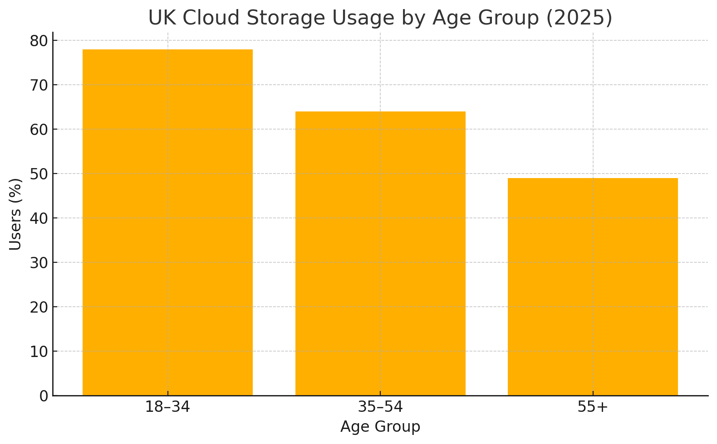Fact Checked | Last Updated: 02/04/2025
Research Highlights:
The number of people using personal cloud storage has more than doubled from 1.1 billion in 2014 to an estimated 2.3 billion users today.
By 2025, total cloud storage usage (both personal and enterprise) is projected to reach 200 zettabytes, which is enough data to fill 1.5 trillion iPhones!
Personal cloud storage has become an essential tool for individuals worldwide, enabling secure, remote access to files, photos, and data. As digital consumption increases, more people are turning to services like Dropbox, Google Drive, and iCloud for everyday storage needs. This research page compiles the latest statistics on personal cloud usage, illustrating the industry's rapid growth and adoption.
Key Statistics on Personal Cloud Usage
1. Global User Growth
- Personal cloud storage users have increased from 1.1 billion in 2014 to around 2.3 billion in 2025.
- Growth is largely driven by smartphone usage, increased internet access, and the demand for mobile-friendly file access.
This doubling in users over a decade makes cloud storage more widespread than credit cards in some regions.
In addition, the global penetration rate of personal cloud storage is now over 29%, with even higher adoption in developed economies. In the UK alone, over 62% of adults report using a personal cloud service regularly.
.png?width=736&height=422&name=output%20(2).png)
2. Cloud Storage Volume
- Cloud storage across all types is expected to hit 200 zettabytes by 2025.
- High-resolution formats like 4K video, RAW images, game installations, and VR/AR content are driving demand.
One zettabyte equals one billion terabytes – a figure that was unthinkable just a few years ago.
For context, global data creation is expected to exceed 180 zettabytes by 2025, with over 20% of this data expected to be uploaded or backed up to the cloud.
3. Service Adoption Rates
- Google Drive leads with 94% of personal cloud users.
- Dropbox (66%), OneDrive (55%), and iCloud (50%) continue to be dominant players.
- Amazon Web Services dominates public and enterprise cloud but has smaller personal adoption (~12%).
Many users prefer services that integrate directly with their devices (iCloud for Apple, OneDrive for Windows, etc.).
Emerging alternatives like pCloud, Sync.com, and Internxt are gaining traction due to their privacy policies and one-time payment options.
.png?width=766&height=422&name=output%20(1).png)
4. Multiple Cloud Services Usage
- 55% of users rely on at least three different cloud services.
- People often spread files across platforms for better organisation, backup, or platform-specific benefits.
For instance, users might store photos on Google Photos, documents on Dropbox, and iPhone backups in iCloud.
A growing number of users are also utilising hybrid cloud strategies, combining local NAS systems (e.g. Synology) with public cloud providers for more control and redundancy.
5. Primary Use Cases
- 71% of people use cloud storage for photos.
- 53% back up important files.
- 41% store entertainment (music, videos, etc.).
Photo storage continues to dominate thanks to smartphone cameras and auto-backup features.
Other emerging use cases include:
- Document scanning and storage (e.g. receipts, tax forms)
- Collaboration for small businesses and freelancers
- Syncing app data across platforms

6. Market Value and Future Growth
- The personal cloud storage market was worth $51.12 billion in 2022.
- It’s projected to grow to $365.92 billion by 2031 (CAGR of 24.4%).
Cloud subscriptions are becoming as common as Netflix or Spotify, especially as providers offer more features and storage tiers.
By 2027, it’s estimated that the average personal cloud user will pay £5.60/month for storage, up from £3.20 in 2022. This reflects rising demand for larger storage plans, privacy tools, and collaboration features.
Security and Privacy in the Cloud
- Data breaches remain a top concern for users.
- Providers are investing heavily in encryption, two-factor authentication, and transparency tools.
- Services like Proton Drive and MEGA focus specifically on privacy-first storage.
Awareness of privacy rights is increasing, and users are paying closer attention to where and how their data is stored.
A 2024 UK survey found that 43% of users were concerned about their cloud provider scanning personal data. As a result, encrypted storage and zero-knowledge platforms are growing in popularity.
Demographics & Regional Trends
- North America and Europe lead in personal cloud adoption.
- Asia-Pacific is the fastest-growing market, especially in mobile-first countries.
- Younger users (18–34) are the most active, but older demographics are catching up as cloud tools become more user-friendly.
In the UK:
- 78% of 18–34s use cloud storage.
- 64% of 35–54s.
- 49% of over-55s, up from just 32% in 2020.

What’s Next for Personal Cloud Storage?
- AI integration (e.g. automatic file organisation, intelligent search, and content tagging)
- Greater cross-platform compatibility
- Better offline access and syncing features
- Cloud-native collaboration (video editing, productivity suites)
As technologies like AI, IoT and edge computing evolve, cloud services will become even more embedded in our digital routines. The next generation of cloud storage will likely blend backup, productivity, and AI assistance into a single experience.
Sources
-
Spacelift.io - Cloud Computing Statistics
-
Cloudwards.net - Cloud Computing Statistics
-
CloudZero.com - Cloud Computing Trends
-
StationX.net - Cloud Security Statistics
-
TopTechNova.com - Cloud Storage User Behaviour
-
StraitsResearch.com - Personal Cloud Storage Market Report
-
Statista - Cloud Storage Usage in the UK
-
Ofcom UK - Online Nation Report 2024
-
IDC - Global DataSphere and Cloud Forecast 2025
Popular Pieces You May Be Interested In:
- How Much Will The SaaS Industry Be Worth By 2025?
- Oracle NetSuite ERP Pricing Guide
- ERP Comparison Guide
